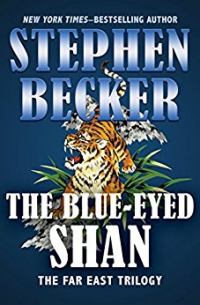
First published in 1982; published digitally by Open Road Media on January 12, 2016
The Blue-Eyed Shan is the last and most pessimistic novel in Stephen Becker's Far East Trilogy, and for that reason it is probably the most realistic. It embodies the “anything that can go wrong, will” philosophy, telling a story in which neither good intentions nor bad intentions have any bearing on the outcome, which seems fated and beyond the control of all earthy intentions.
Greenwood is a Harvard-educated American who has yellow hair and blue eyes, but he speaks Shan and has a daughter in Pawlu. Greenwood was trained as an anthropologist, chasing old bones in Burma, where he happily lived as a Shan before the war. Learning that the Japanese had invaded Burma and attacked America, Greenwood decided to join the American army and fight for his homeland. And that he did, sort of, without leaving Burma.
Greenwood’s army tale is told as a backstory. As a reader would expect of Stephen Becker, it is an amusing backstory that establishes Greenwood’s character, warts and all. In the present, as the novel starts, Greenwood is back in Burma at the request of Yang, the Chinese general he befriended during the war.
Meanwhile, about a hundred soldiers in the Chinese army, the remnants of a much larger force, are on their way to Pawlu, under the command of General Yang. One of the soldiers, Colonel Olevskoy, is Russian. He would prefer to be going to Hanoi, where people speak French and drink decent wine, but Yang has a plan and a couple of mysterious chests. What sort of treasure might they contain?
The Shan in Pawlu are guided by the Sawbwa, who is disappointed that they must kill so many bandits to protect their village.On the other hand, he doesn’t so much mind killing the Wild Wa, because they would gladly kill the Shan if they had the numbers to do it. The Sawbwa would like the Shan to follow the teachings of Buddha, but he has an obligation to keep his people safe. He delegates that task to Naung, the First Rifle, who sees killing bandits as a way to maintain Pawlu’s supply of ammunition — while adding whatever weapons the bandits might be carrying to their stockpile.
The plot eventually brings together Greenwood, General Yang, Colonel Olevskoy, the Shan of Pawlu, and the Wild Wu. It is something of a nightmare for everyone. The ending is a true surprise, but not one that will appeal to fans of the happily ever after.
The anthropologist in Greenwood can’t resist discussing the cultural differences of various tribes. He searches for wisdom and imparts some of it to the reader, to the extent that differing values tell us what is common about the human condition. There are other bits of wisdom laced throughout the novel, and the characters are finely drawn, but the story isn’t as substantial (or as fun) as the first two novels in the trilogy. It’s certainly worth reading for the sense it creates of postwar Burma and for Becker’s remarkable prose, but it doesn’t quite stand up to The Chinese Bandit or The Last Mandarin.
RECOMMENDED